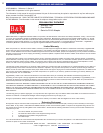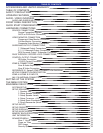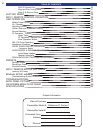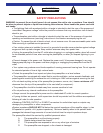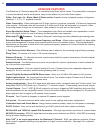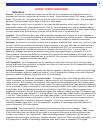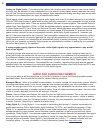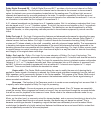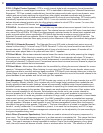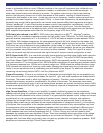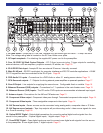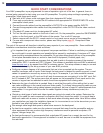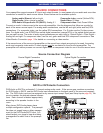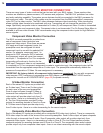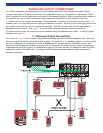
DTS 5.1 (Digital Theater Systems) - DTS is a multi-channel digital audio compression format transmitted
over optical digital or coaxial digital connections. DTS is dedicated to delivering the “Ultimate Entertainment
Experience.” DTS has created a media-delivery format that makes audio tracks sound more dynamic, more
realistic and more closely matching the original than other digitally encoded soundtracks and consumer
media. Coupled with the multi-dimensional playback benefit of surround sound technology, DTS audio quality
dramatically improves and enhances content. DTS 5.1 is an ultra realistic home theater environment, it
delivers discrete channel precision plus the all-enveloping realism for which DTS is renown. For more infor-
mation on the various DTS formats, visit www
.DTSonline.com
.
DTS NEO:6 - An advanced matrix decoder. It will take any two-channel source and expand it into five or six
channels, depending on the user's speaker layout. Two-channel sources include VHS tapes, broadcast televi-
sion, stereo CDs and DVDs. DTS Neo:6 provides separate, optimized modes for stereo music materials and
matrix surround motion picture soundtracks. DTS Neo:6 also decodes a center-surround channel from
Extended Surround matrix soundtracks. Music and movie filters can be applied to the NEO:6 decoder. The
differences between these two filters apply primarily to the differences in the type of soundtrack being played
back.
DTS-ES 6.1 (Extended Surround) - The Extended Surround (ES) adds a discrete back center-surround
channel to the existing 5.1-channel array. DTS-ES Discrete 6.1 is the only home format that can deliver 6.1
discrete channels. DTS-ES is fully compatible with all types of multi-channel systems. All sounds will be
heard even when played back on a system with less than 6.1 speakers
DTS Neo:6 Movie - Movie steers decoded material toward the center channel while preserving the integrity
of the stereo mix. When listening to movies using the DTS Neo:6 movie decoder with stereo TV shows or
other surround-encoded programs, there is further enhancement to soundfield directionally, which is close to
the quality of discrete 6.1-channel sound. Conventional narrow band monaural surround channel is played as
stereo with a more realistic feel and movement.
DTS Neo:6 Music - Music steers the effects into the soundfield by utilizing the surround channels for a more
spacious, 3-dimensional feeling. When listening to music using the DTS Neo:6 music decoder, stereo music
recordings are able to provide a wide and deep soundfield. DTS Neo:6 music decoder allows you to tailor the
Center Image to your own preference. The Center Image control allows the sound of the center channel to be
placed between its own speaker and the left and right front speakers.
Bass Management - Dolby Digital and DTS-ES formats may contain up to 6 full range channels plus an LFE
(Low Frequency Effects) channel. Only a system with six full-range (large) speakers plus a subwoofer can
directly reproduce these formats. However, almost all commercially available center channel speakers and
bookshelf speakers are considered small and incapable of reproducing the lowest bass frequencies without
distortion or even damage to the speaker. Many people use small speakers in the rear of their system, while
others use small speakers for all channels. Some people may choose not to use a center channel or
surround speakers at all. Use of a subwoofer is mandatory when using small speakers to reproduce low
frequencies. In order to handle any possible combination of large, small, or missing speakers, a home theater
system must contain good bass management. Your B&K preamplifier contains a complete bass manage-
ment system. You can use as few as two large (full range) front left and right speakers or two small front left
and right speakers. Wherever a small speaker is used, the bass management system filters low frequency
information from going to that speaker ("high pass"). This bass information is re-routed to a speaker that can
handle it, usually a subwoofer. If no subwoofer is present, it can send the low frequency and LFE to large
front or surround speakers. The bass management crossover point can be adjusted by the user according to
the types of speakers being used.
Notch Filters (Parametric Equalization)- Notch filters are used to enhance the frequency response of a
given room. The full range frequency spectrum in an ideal scenario is completely flat. This means that there
is no variation in the decibel level between any of the frequencies as you sweep up or down the frequency
range. This type of response is almost impossible to achieve. Due to the physical geometry of any given
room, the sound waves will bounce off walls, doors or windows within the room. This reflection of sound
8



